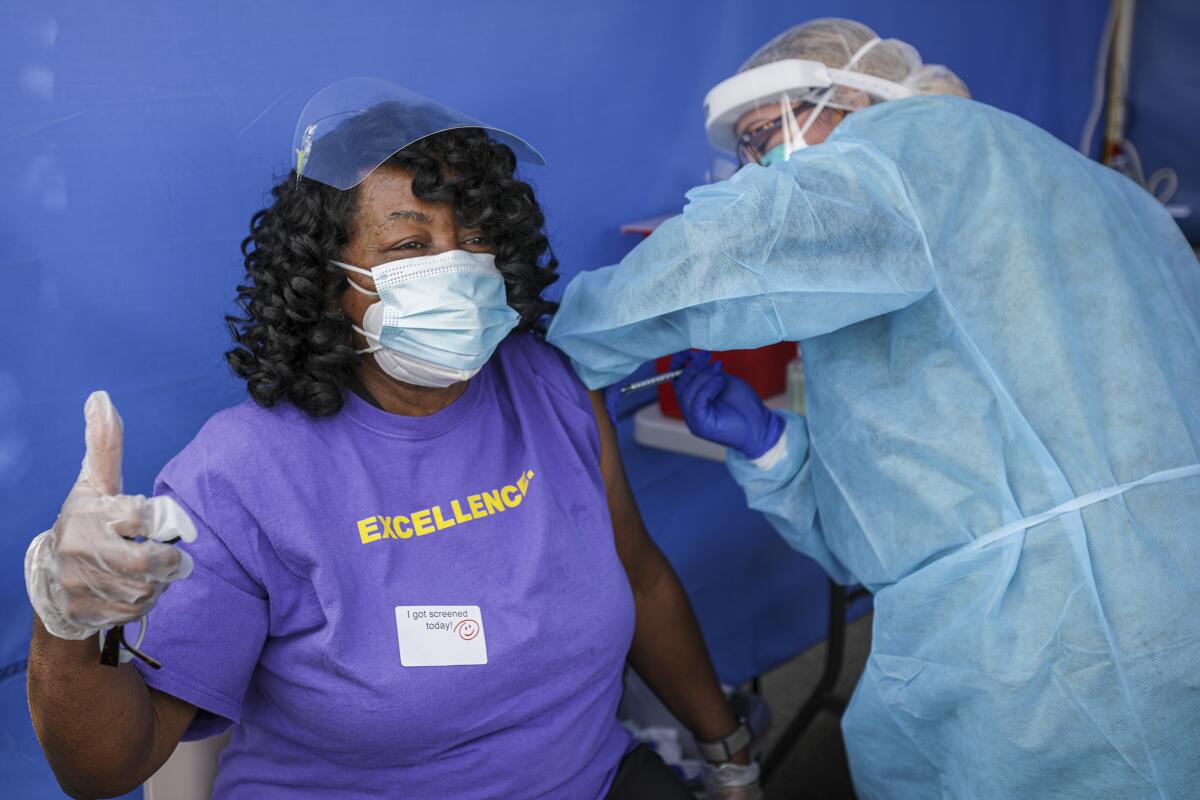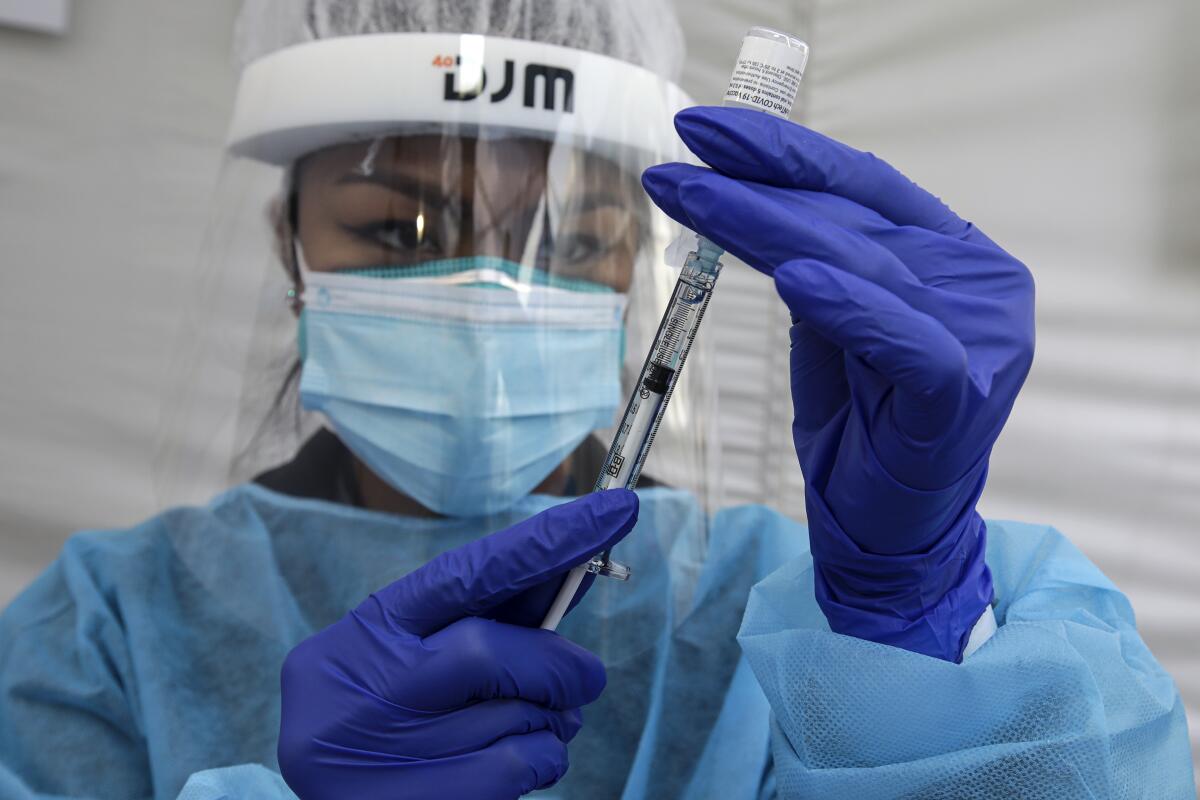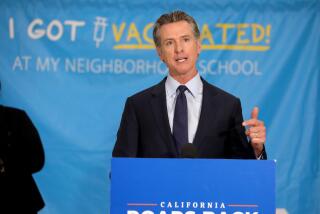How will the self-employed get vaccinated? There’s no clear answer

As a midwife, Tania McCracken spends hours with pregnant women and their families inside their homes, helping deliver newborns. The essential hands-on work puts McCracken and other California midwives at risk of COVID-19.
“There’s a lot of breathing involved,” she said, noting that scientists have found that labor, like singing, may spread the virus through the air.
But McCracken, who works in homes around Redlands in San Bernardino County, and many other state-licensed midwives have not yet been able to get the COVID-19 vaccine even though health workers have been prioritized to receive the shots before all others.
The problem stems from midwives’ work as independent practitioners. Most do not work directly for hospitals or other health systems, which were given some of the first supplies of the vaccine and have focused on inoculating their own staffs.
The difficulties of midwives in getting vaccinated raise questions about how independent workers in other professions deemed essential will gain early access to the vaccine once more supply is shipped. Independent contractors and the self-employed make up about 12% of California’s workforce, according to a study by researchers at UC Berkeley.
In healthcare, it’s not just midwives who have struggled to get vaccinated, even though they are at risk of contracting the virus.
Dozens of physicians, nurses, physical therapists and others not directly employed by hospitals posted pleas on a website that had allowed the public to comment on the work of a state vaccine advisory committee trying to distribute the shots.
Many of those health workers point out their jobs don’t allow them to “socially distance” or keep at least six feet away from those outside their household — the current guideline from federal health officials for avoiding getting infected.
“Why have people like me been forgotten?” Erin Newman, a self-employed audiologist in Orange County wrote to the committee. Newman said she was spending 45 minutes with each patient, much of that time within inches of them, as she evaluated their hearing. The local medical system had told her its doses were for its staff, she said.
Cristina McDorman told the committee that her husband, a self-employed medical gas technician, had been repairing oxygen outlets inside the hospital rooms of COVID-19 patients in Southern California since March. The failure of pipes getting oxygen to patient rooms has been a problem for some hospitals with the new surge of cases.
“His hospitals have told him that they cannot get him a vaccine,” McDorman wrote.
Getting the vaccine to health workers was expected to be easier than providing it to workers in other industries. Health systems were already set up to deliver vaccines and many of those qualifying for the shots work on site or nearby.
But the state’s delivery of the first wave of shots has been slower than expected. As of Saturday, California had delivered just 734,405 doses of the 2,180,725 it has received and shipped to counties for distribution.

And problems could multiply, including for the self-employed and independent contractors in other industries, as more doses become available and sites outside of hospitals begin offering the shots.
After health workers and the residents of nursing homes are vaccinated, priority will expand to workers in education, child care, emergency services, and food and agriculture, according to guidelines set by the state. That priority group also includes Californians age 75 and older.
Next in line are workers in transportation and critical manufacturing, along with those 65 to 74 years old.
Independently-employed transportation workers include those working for ride-hailing company Uber, which has been lobbying government officials across the country for early access.
Once those in transportation and critical manufacturing are vaccinated, next in line are workers in industries such as water and wastewater utilities, defense, energy, communications and financial services.
Early access to vaccines for a worker in any industry in California only applies if their job puts them at risk of being exposed to COVID-19. Those who can protect themselves by working from home must wait like the rest of the general public until enough doses are available, something that is expected later this year.
Already some self-employed essential workers in industries outside of healthcare are worried they’ll be moved to the back of the line because they don’t have a corporate badge to prove their employment.
“I am a self-employed teacher and my wife is a child-care provider,” Lee Young wrote to the state advisory committee. “We both work with children, but we own our own business. … We need your help to ensure that we are not left behind.”
Damaris Bautista told the committee she was concerned for independent contractors who were essential workers but not part of a large organization. She said her father owned a small business doing janitorial work — a job that puts him at risk of exposure to the virus.
“If he were to be a part of a large corporation that employed janitorial services, he would have a priority,” Bautista wrote. “How will small businesses or independent contractors not be penalized?”
Government officials are still trying to create systems that can verify employment without shutting out essential workers who don’t get a corporate paycheck or need a state license to operate.
“It is a balancing act,” said Lori Tremmel Freeman, chief executive at the National Assn. of County and City Health Officials. “How many hoops do you want to push people through? What is your real priority — getting vaccine in arms, doing it fairly and equitably, or focusing on the people most at risk?”
Last week, some people who weren’t health workers and not yet qualified for the vaccine jumped the line and got a shot in Los Angeles before officials were requiring documentation of their employment.
L.A. County officials are now requiring healthcare workers to provide an employer badge, a professional license combined with a photo ID, a signed letter from their employer or a payment stub before they can get their shot.
County public health officials told The Times that other groups of essential workers, including those in child care, will be able to use their state licenses as proof of eligibility, once the priority list is expanded.
The officials said it will be harder for agricultural workers who move from farm to farm to verify their jobs.
“We are working on plans now as to how these individuals will be identified and vaccinated,” the county public health officials said in a written statement to The Times. They noted the county has about 42,000 agricultural workers.
Other workers say they don’t know how they will verify their jobs are essential.
Wilma Bianchi, a resident of Lodi, told the state advisory committee that she was caring for her grandchildren while her daughter worked as a schoolteacher.
“I have no way to prove I am a child-care provider,” Bianchi wrote.
More to Read
Inside the business of entertainment
The Wide Shot brings you news, analysis and insights on everything from streaming wars to production — and what it all means for the future.
You may occasionally receive promotional content from the Los Angeles Times.











